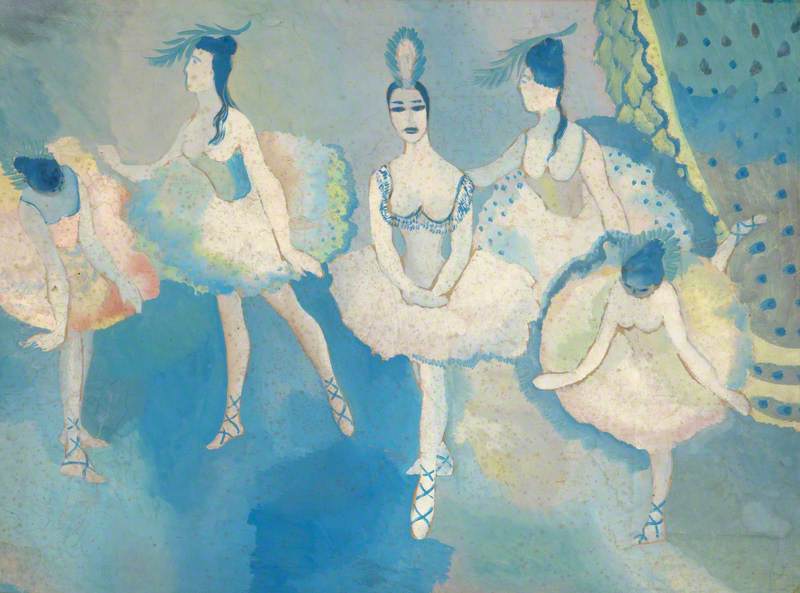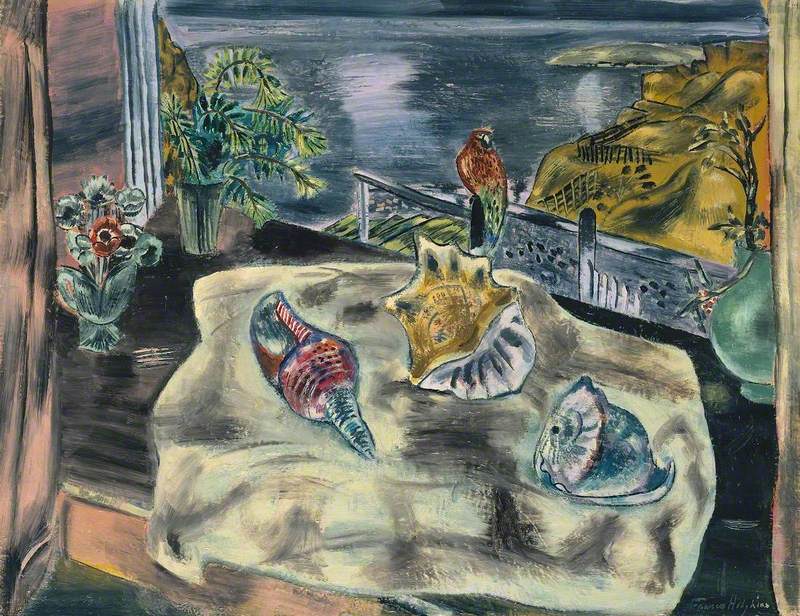The Towner Collection is an ever-growing collection of 5000 works of modern British and international contemporary art, with a focus on landscape, women artists and moving image.
Art Unlocked is an online talk series by Art UK in collaboration with Bloomberg Philanthropies. This Curation is based on a talk by Karen Taylor, Collections & Exhibitions Curator at Towner Eastbourne, on 6th July 2022. You can find a recording at https://youtu.be/AZAfBkCOnhY
-
Still Life c.1929
New Zealand-born Frances Hodgkins taught art and worked as an illustrator before she left to pursue her career as an artist in Europe, where she was known for her ‘plein air’ painting. It was not until 1913 that she began to experiment with the modern style that she is known for now, influenced by the work of Matisse and Dufy.
This oil was painted at Wilmington, Sussex, where Hodgkins stayed in the summer of 1929. The placement of a still life against a landscape is a composition often explored by Hodgkins, however, unusually there are figures as part of the setting.
Frances Hodgkins (1869–1947)
Oil on canvas
H 62 x W 75 cm
Towner
-
Constant Lambert (1905–1951) 1927
Christopher Wood painted his friend, the composer Constant Lambert, three times. In this portrait the sitter is part naked, casually reclining with a violin under his arm, a stone bust behind him and a manuscript paper and pen, poised to compose. Whereas in Wood’s painting of Lambert in the National Portrait Gallery collection the pose is formal, and he is fully clothed in a suit.
This work was one of many paintings by Wood that Lucy Wertheim owned – she had met Wood in 1929 when she purchased his oil Purple Crocus, 1929. Wertheim collected his work throughout her life and dedicated herself to promoting his reputation as an artist.
Christopher Wood (1901–1930)
Oil on canvas
H 57 x W 89.5 cm
Towner
-
Bullfight c.1930
German painter Helmut Kolle travelled extensively as a young man, until he settled in Chantilly, France with his partner and mentor, the German art collector Wilhelm Uhde (1874–1947). Kolle’s dark, powerful paintings often depict men in roles seen traditionally as strong – such as boxers, bullfighters and soldiers. These roles were in marked contrast to his own, as since 1922 he was weakened through an ongoing heart condition.
Bull Fight featured in Kolle’s first English solo show at the Wertheim Gallery in March 1931, but he was unable to attend the opening due to ill health. The exhibition was not received well by the public or critics.
Helmut Kolle (1899–1931)
Oil on canvas
H 78.5 x W 113.5 cm
Towner
-
Rose Nudes in a Landscape 1916
Phelan Gibb studied in Newcastle, Edinburgh, Antwerp and Munich, before starting up his studio in Paris, where he lived for twenty-five years. There he moved in the same circles as Matisse, Braque and the modernist writer Gertrude Stein. At the height of his career, in 1913, he was one of the few British artists invited to exhibit in the International Exhibition of Modern Art in New York alongside Duchamp, Picasso, Matisse and Brancusi.
In 1930, Gibb having fallen on bad times and in his sixties, sought out Lucy Wertheim with the intention of selling all his paintings to the gallerist. Wertheim wrote, ‘One day Gibb will doubtless come into his own, and his finest paintings take their place alongside examples of Manet, Cezanne, Picasso.’
Harry Phelan Gibb (1870–1948)
Oil on canvas
H 137 x W 244 cm
Towner
-
Ballet Dancers c.1938
Kathleen Walne’s paintings are highly recognisable, characterised by her fluid brush work, in contrasting colours whether blocked or highly patterned, combined to create a composition abundantly rich and visually arresting.
Walne worked as Lucy Wertheim’s assistant at the Wertheim Gallery from 1934 and was prone to impulsive bouts of painting despite contradictory instruction. She left several years later when she married and thereafter trained to be a nurse but continued to paint throughout her life. Walne and her husband moved to Brighton in the late 1960s to care for Lucy Wertheim for the final years of her life.
Kathleen Walne (1915–2011)
Watercolour on paper
H 35 x W 50 cm
Towner
-
Trafalgar Square c.1937
Kenneth Hall made a series of London landscapes, with heavy black lines denoting the form of the buildings and streets over flat garish colours. He contributed one such painting Cork Street to an annual exhibition of the Twenties Group - an exhibiting collective of artists in their twenties held annually at the Wertheim Gallery.
In the mid-1930s Hall met Basil Rákóczí at a meeting of the Society for Creative Psychology, which Rákóczí had formed with Herbrand Ingouville-Williams. The society's methodology was based on ‘the natural rhythm of life’, the focus was discussion, psychoanalysis and group therapy. The paintings Hall and Rákóczí produced drew upon the results of these meetings and together they exhibited as the White Stag Group.
Kenneth Hall (1913–1946)
Oil on canvas
H 150 x W 126 cm
Towner











